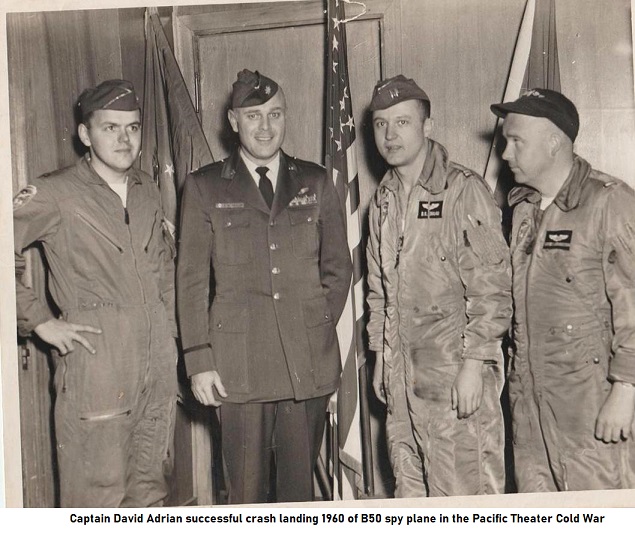
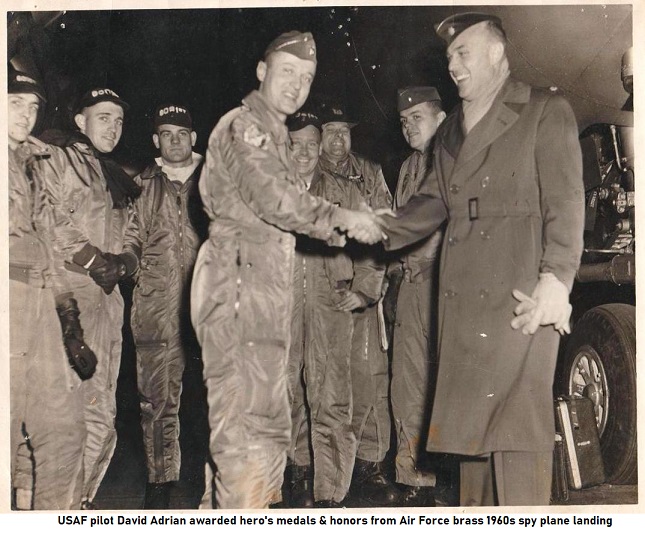
The CIA's Secret Corona Spy Satellite Program
https://www.youtube.com/watch?v=rLmpXgdgNZM
The CIA's Secret Corona Spy Satellite Program--NRO
run GAMBIT program 1963 to 67 during this era David Adrian worked for USAF)
Hexagon program 1971 to 1986 and declassified
from NRO 2011 (during this era David Adrian
worked on and off for NRO)

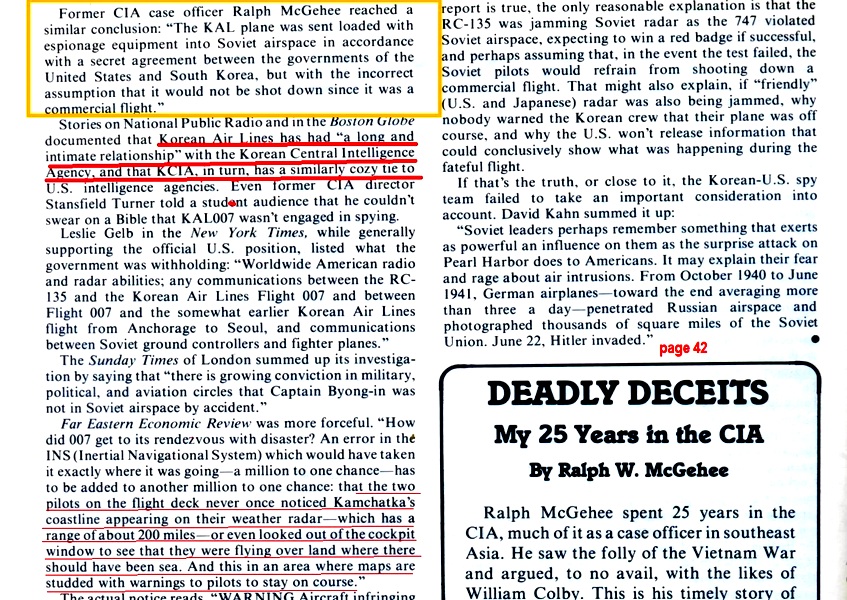
WINTER
1984 “COVERT ACTION” periodical on Korean Airline KAL007 spy plane
https://covertactionmagazine.com/wp-content/uploads/2020/01/CAIB20-1984-1.pdf
(page 42)
**********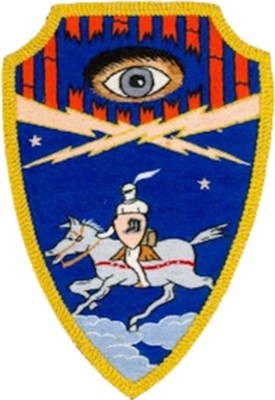 click here
click here

David H. Adrian could have most likely been carrying nuclear bombs on his AF
airplane when he crash landed on Wake Island in the 1960s, due to 3 out of 4
engines burning rapidly due to electrical shorts and overheating, in those
reckless and heady times, not long after the USAF dropped A-bombs on Nagasaki
and Hiroshima. Just 20 years later Capt. Adrian trained all the pilots of
Korean Airlines, one of those pilots being responsible for the KAL007 cold war
shootdown and standoff on Sept. 1, 1983, which three weeks later (Sept. 26,
1983) resulted in the famous incident of "the Russian who prevented
WW3," Stanislav
Petrov, the lieutenant colonel in the Soviet Union's Air Defense Forces who died very recently.
David H. Adrian was in two 'near' end-of-the-world COLD WAR
scenarios. As pilot in the Wake Island emergency crash of the early 1960s, and
the training of the Korean Airline pilots in the early 1980s, one of whom ended
up flying into Soviet Air space in 1983 causing the KAL007 commercial jet to
disintegrate and disappear forever. Read more below.
Many of the classmates of David H. Adrian, went very high up the ladder into top positions in
NASA, NSA, CIA, and NRO after graduating with him from this very special
officers corps training grad school for the military in 1956, during the height
of the Cold War. About 47 grads from Class of M'56 --some became NASA astronauts, others a governor or Florida at least half who went on in internal affairs of NORAD; CIA; DOD; REDCAP; CALSPAN; AMRAAM; NRO; NGA; NGIA!!
56M Pilot Training
Class/Pilot Officers who graduated 1956, roster
New
York Times latest article on Eisenhower's targets for A-bombs location list,
1956, in case of need...recently declassified by THE NATIONAL ARCHIVES of
Washington DC
DAVID H.
ADRIAN
David served in Japan at Yokota Air Base
in secret TDY spy flights over China and Russia in the
early 1960s. Infrared photography, etc. Reconnaissance
flights. Just before, during, and directly after Gary Powers U2 spy-plane
shootdown. Afterwards was professor at
the Citadel Military University in Charleston, SC. He
divorced his wife/family and left the Air Force, circa 1965. Then became a
pilot for ONA and Evergreen. In the early 1980s he was the flight trainer
for the Korean Airlines KAL pilots. KAL had just purchased many Boeing
aircraft.
Some more slices of Adrian Family history: First & 2nd
generations of pioneer stewardesses, 1950s TWA first batch, then 2nd generation
flight attendants early 1960s batch with PanAm....
https://www.youtube.com/watch?v=EZeVxqRpWMo

Dolores Adrian (nee Wolke-Osweiler German American), was one of the eight
stewardesses in the first batch of graduates of stewardesses in US history in
the early 50s. This TV series PAN AM was set in the early 60s, after the
first ladies had paved the way which had been uncharted before them by TWA
stewardesses. Dolores Osweiler-Wolke married
Captain David Adrian, who indeed like in the PanAm television
series, was a pilot who doubled as an operative for US
spy agencies too!
In the 1950s &
1960s stewardesses appearances meant so much that the airlines all competed for
the top names in fashion to come design the in-flight uniforms. In its heyday,
TWA snagged Oleg Cassini, Pierre Balmain and Ralph
Lauren. For
many years, when a young woman signed up to be a TWA stewardess, she agreed to
a contract stating that she would retire at the age of 35 or when she got
married — whichever came first.
Earliest TWA
stewardesses
https://nypost.com/2019/05/22/twa-flight-attendants-expose-sexist-seedy-world-behind-the-glamour/
David Adrian pilot
https://kal007mystery.tripod.com/CLASS-56.html
links of interest....
https://en.wikipedia.org/wiki/National_Reconnaissance_Office
https://en.wikipedia.org/wiki/Pan_Am_(TV_series)

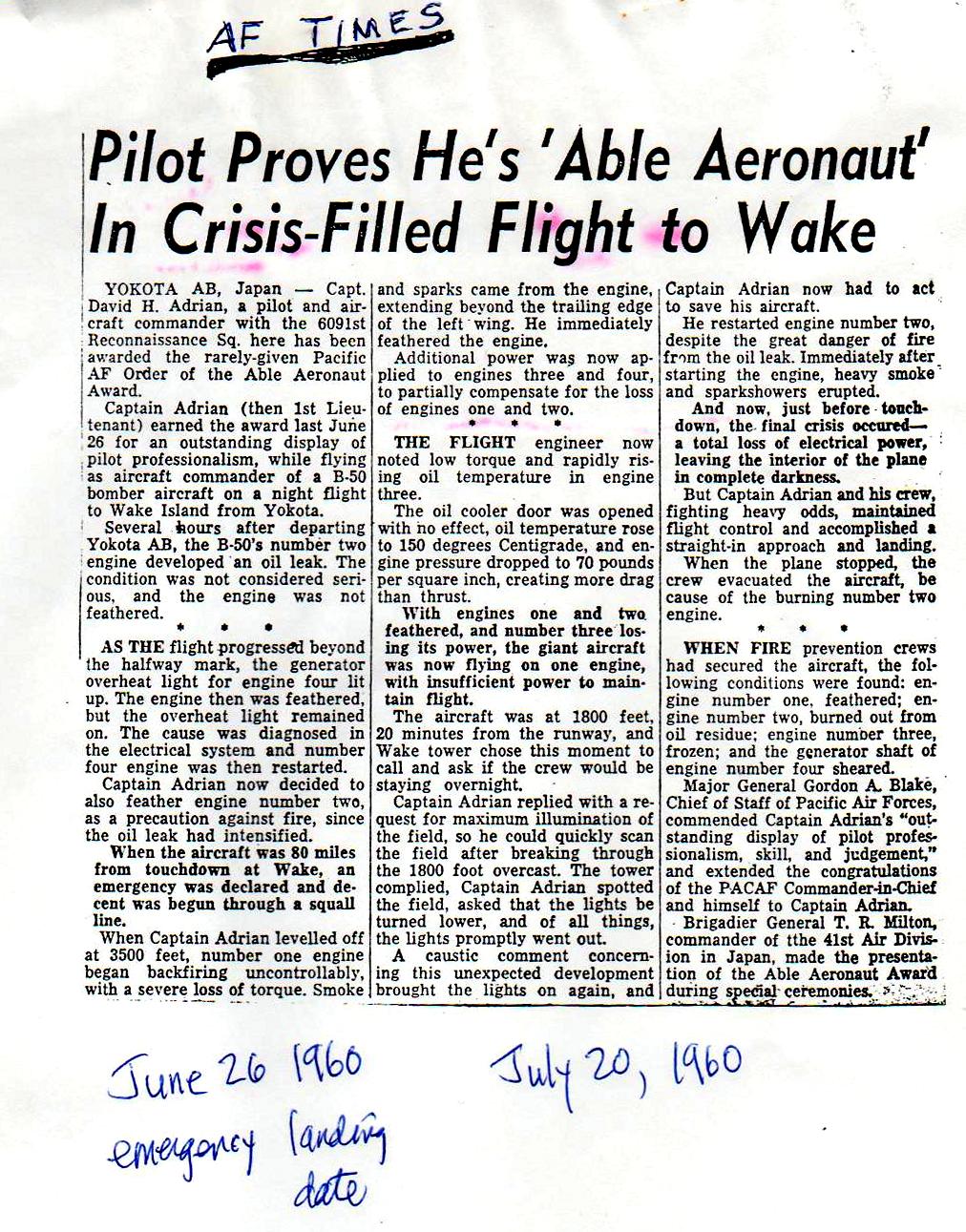
------------------------------
------------------------------
Recent Okinawa NEWS:
The controversy around this date above unveils the
little-known world of Air Force nuclear launch crews on Okinawa – many of them
young enlisted men fresh from stateside training – who more than a half-century
ago kept watch on the Soviets from reinforced bunkers during one of the most
dangerous moments in human history. Bolo Point nuclear missile site
at Yomitan, Okinawa, where John Bordne claims he received a
launch order.
http://thebulletin.org/okinawa-missiles-october8826
The Okinawa missiles of October-- Oct. 28, 1962.
Airman John Bordne; Capt. William
Bassett; 498th Tactical Missle Group TAC; FOIA
------------------------------
John F.
Mitchell
http://website56m.tripod.com/id6.html
In his 28 years at CAL (later named CALSPAN), John
was also involved in Human Factors and Training, with such programs as the Navy
E-2C, F-18A, and T-45, utilizing the Air Force systems approach to training for
the B-1A. In addition, he worked at the Real Time Electromagnetic Digitally
Controlled Analyzer and Processor (REDCAP) Air Force facility, which was built
and installed at CALSPAN.
The purpose of REDCAP was to simulate the former
Soviet Command and Control operations: from Early
Warning, Filter Centers , and SAM sites to first line aircraft.
It included an elaborate hardware and software simulation of the Soviet AWACS,
with four operators making decisions in real-time regarding US bomber
penetration.
During his tenure in western New York ,
John took the opportunity to fly the T-33A, F-100C, F-101B, and F-4C with the
Air National Guard at Niagara Falls , where his unit had Air Defense
Command alert duties with the F-101 Voodoo interceptor. He retired from the
military in November 1982 after 28 years of active and reserve duty.
When the REDCAP facility relocated from Buffalo to
Edwards in 1995, John retired from CALSPAN. Since five of seven children work
and live in the Washington, DC metropolitan area, John and Sue decided to move
to nearby Northern Virginia, where he took a position as a cartographer with
the Defense Mapping Agency (later renamed the National Imagery and Mapping
Agency) and more recently to the National Geospatial-Intelligence Agency
(NGA). He worked until his retirement from Civil Service in February of
2003.
Three
years after graduation from flight training, John married Susan A. LaFramboise
of Michigan in 1959. Their seven children include four in the D.C.-area and one
in St. Louis : two work at NGA Spatial Intelligence Agency, and one each are
with NASA Greenbelt, CIA Langley, and the Navy. Of the two remaining children,
one lives in Rhode Island and the other in Michigan , where he works for
Astra-Zeneca pharmaceuticals.
NATIONAL GEOSPATIAL INTELLIGENCE AGENCY 2004 Mobile
Integrated Geospatial-Intelligence System (MIGS II)
The MIGS first appeared after Operation Allied Force
in Kosovo, when NGA recognized the need for a deployable system able to
move with the troops. The MIGS was equipped with the essentials to maintain
life support and easy transportation and was able to withstand harsh conditions.
MIGS II was a leaner version deployed to support Operation Iraqi Freedom. It
resided on a HMMWV (High Mobility Multipurpose Wheeled Vehicle) and could be
unpacked within two hours. Personnel inside the MIGS had the necessary
capabilities to produce NGA-tailored products to support the warfighter in
the Caucasus theater.
EUGENE
KRANZ
http://website56m.tripod.com/id3.html
As the leader of the “Tiger Team” of flight
directors who brought the Apollo 13 spaceship safely back to Earth on April 17,
1970 , Gene Kranz demonstrated extraordinary courage and heroism. The hit
film, Apollo 13, chronicles Kranz’s struggle to devise the plan that would
safely bring the ship and its crew of three astronauts home after its oxygen
system failed. Actor Ed Harris portrays Kranz in the film, which was directed
by Ron Howard.
Kranz retired from NASA in 1994 after 37 years of
federal service, and is currently a consultant and speaker. “Failure is not an
option,” the motto that carried him through the Apollo 13 crisis, is a major
theme of his motivational message.
After receiving his BS degree in aeronautical
engineering from Parks College of St. Louis University in 1954, Kranz was
commissioned in the U.S. Air Force and flew high performance jet fighter
aircraft, including the F-80, F-86, and F-100. In 1958, he worked as a
flight-test engineer for McDonnell Aircraft, developing the Quail Decoy Missile
for B-52 and B-47 aircraft.\
Kranz joined the NASA Space Task Group
at Langley , Virginia in 1960 and was assigned the position
of assistant flight director for Project Mercury. He assumed flight director
duties for all Project Gemini Missions, and was branch chief for Flight Control
Operations. He was selected as division chief for Flight Control in 1968, and
continued his duties as a flight director for the Apollo 11 Lunar Landing
before taking over the leadership of the Apollo 13 “Tiger Team.” He was
discharged from the Air Force Reserve as a Captain in 1972
He contributed his expertise to a number of other
NASA missions during his career, including the Skylab Program. After the Skylab
Program concluded, he was named deputy director of Flight Operations for NASA,
which gave him the responsibility for space flight planning, training, and
mission operations, aircraft operations, and flight crew operations. In 1983,
he was assigned the post of director of Mission Operations, and given the
responsibility for all aspects of mission design, development, maintenance, and
operations of all related mission facilities, as well as the preparation of the
Space Shuttle flight software.
Kranz has received many awards and honors, including
the Presidential Medal of Freedom, which he received from President Nixon for
the Apollo 13 mission, and his designation as a Distinguished Member of the
Senior Executive Service by President Reagan.
After retirement, Kranz served as a flight engineer
on a B-17 “Flying Fortress” and constructed an aerobatic biplane. In April
2000, he published a memoir about his experiences in the space program, Failure
is Not an Option: Mission Control from Mercury to Apollo 13 and Beyond. His
book, a New York Times best-seller, has been selected by The History Channel as
the basis for a documentary on Mission Control. He and his wife are the parents
of six children, and reside in Texas .
Fred
Horky
http://website56m.tripod.com/id39.html
At the time of our April 27th, 1956 graduation from
pilot training (in my case, at Webb AFB) Fred hadn’t yet taken the plunge of
signing on for USAF career status, so the first assignment was to Troop
Carrier, now known as Tactical Airlift. This was to Pope AFB in North
Carolina , flying the venerable Fairchild C-119. Flying hours added
up fast in those days, so by mid-1958 Aircraft Commander status had been
attained.
Those were the days of Sputnik and the “Space Race”,
so missiles were the hot ticket de jour. When his engineering degree
opened the door, Fred took the opportunity to go to Europe with the
Martin Mace (TM-76A then, later MGM-13B) system. First there was a year of
training, starting with a PCS to the first officer class on the system at Lowry
AFB in Denver . This was followed another PCS to launch crew
training at Orlando AFB, FL.The system was brand new and training was combined
with final acceptance testing, so his crew was fortunate to have two live
launches while on TDY to the desert test range at Holloman AFB, NM. In
July 1959 the unit deployed the Mace to Sembach Air Base, Germany .
In Germany working up to operational
status with the new system was very demanding, but there was time for the
required “proficiency flying”, at first in the venerable “Gooney Bird”
(C-47). This included excitement like Berlin Corridor checks (and visits
to pre-wall Berlin itself, of course!) and other treats of those
forgotten times of “weekend cross-countries”. For the last two years Fred was
attached for flying to a small, specially-equipped, mission-coded T-33 unit at
Sembach. Their mission was to provide “simulated missile” training for
ground-based weapons controllers who would guide the older TM-61 “Matador”,
then still operational with other missile units. Considering that these
“sim-missile” missions were flown in very tight airspace confines next to a
very hostile border, this “behind the lines”, additional duty flying was some
of the most exacting of the career!
A couple of years after retirement Fred hired on
with Lockheed at Marietta GA , as a reliability/maintainability
engineer. The work was on a classified, “black” program in an informally
named “Skunkworks East”. The project was eventually cancelled, but to our
knowledge is still classified, so nothing more can be said about
that. During this period Linda continued teaching French in Warner
Robins High School , so Fred commuted each week to a condo
in Marietta for the Lockheed job. When the Lockheed program was
cancelled, it was decided that all this travel wasn’t really necessary,
so Warner Robins became “home” for good.
In 1974 Fred was selected for Military Assistance
advisory duty, which meant first attending the Defense Language Institute at
the Presidio of Monterey, California; followed by assignment
to Caracas , Venezuela as the aircraft maintenance advisor
to the Venezuelan Air Force. This was a most interesting assignment, but
when in 1977 the assignment orders back in the states was to a SAC
northern-tier base, it was time to turn in the blue-suit in favor of civilian
life.
There followed many adventures and deployments with
the “Herk”. Among them was with a 1964 deployment with a TDY “rotation
squadron” to Europe , from which the squadron further suddenly deployed
to Africa on “Operation Dragon Rouge”. This was the combat
airdrops in the former Belgian Congo of a battalion of Belgian “Paracommandos”
that the Pope crews had flown from Europe to the Congo, the task force being
sent to rescue a couple of thousand multi-national hostages that had been held
for months and were being threatened with massacre by rebel forces in a very
vicious civil war. Among other awards for that mission, the parent 464th
TCWg won the Mackay Trophy for 1964.
http://website56m.tripod.com/id6.html
Lloyd
Reeder
http://website56m.tripod.com/id16.html
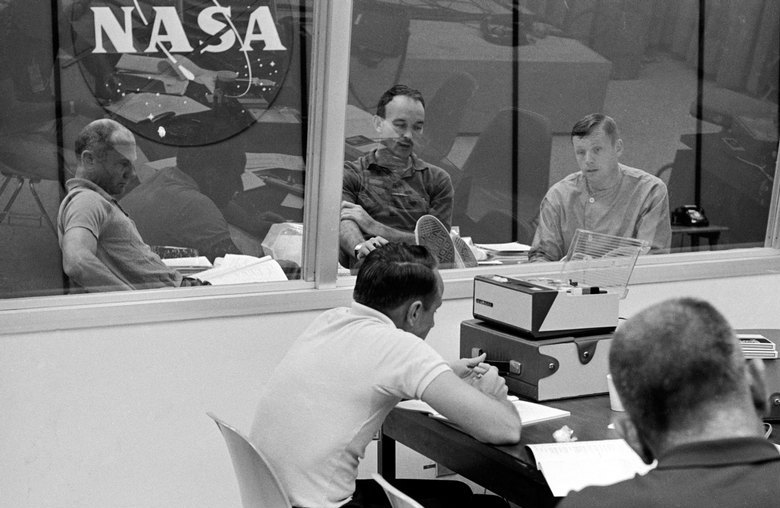
2006 http://www.findagrave.com/cgi-bin/fg.cgi?page=gr&GRid=15770012
He played a critical role in getting the Apollo
spacecraft approved for flight after the disastrous fire on Apollo 1, and
then went on to play a leading role in the successful training of astronauts
for Apollo 11 and Apollo 13. His promotion to Lt. Colonel was due in
part to an evaluation written by James A. Lovell, Captain USN, for his work on
Apollo 13, which was endorsed by Thomas R. Stafford, Colonel USAF, and Apollo
astronaut. The last big bang in his post Air Force career, with Lockheed
Martin, was leading the launch team for the 1st Titan IV Centaur/Milstar launch
on February 7, 1994.
Details: Flying and the Air Force were a very
important part of his life and fortunately they were both good to him. After
graduating with you, his classmates in 56-M, Lloyd went on to San
Antonio where he flew B-25's and B-29's during multi-engine training. The
next stop was McClellan AFB in Sacramento and his first date with an RC-121
Super Constellation. After a quick trip to Montgomery for Squadron
Officer's school, he returned to Sacramento and drilled holes in the
sky over the Pacific until he was transferred to Yakota AFB outside
of Tokyo. At Yakota he kept current in a T-33 (becoming an instructor
pilot) while working as an Operations Officer, where he honed his skills in
planning and logistics that would help him succeed at NASA and Martin Marietta.
Three short years later Lloyd was back at McClellan
for his second date with "Connie". He participated in the Cuban
Missile Crisis; flying over the ocean, right on the deck, in an RC-121 (with
the radar pointing up) providing critical radar coverage for reconnaissance
aircraft over-flying Cuba .
In 1963 the Air Force took Lloyd out of the sky and
moved him underground as a Minuteman Missile Launch Crew Commander and
Instructor at Whiteman AFB in Knob Noster, Missouri . At Whiteman,
Lloyd earned an MBA from the University of Missouri , and
actually got to launch a Minuteman from Vandenberg AFB as part of a test. The
warhead landed in an atoll in the South Pacific, close enough to the aiming
point to have vaporized it with a real nuke. To keep current, Lloyd flew a U-3A
between stints in the capsule and a graduate school classroom.
In November of 1967 the Reeder family moved
to Friendswood , Texas as Lloyd traded an inground capsule
for one designed to fly to the moon. His original assignment at NASA was as a
liaison between NASA and USAF. However, he immediately got bored and
volunteered to participate in a test of the Apollo spacecraft to monitor and
evaluate redesigned components. Along with two other Air Force pilots, Lloyd
completed a few months of Astronaut training, donned a spacesuit, headed into
the vacuum chamber and climbed into an Apollo spacecraft that was sitting on a
turntable, surrounded by sun lamps on one side and radiators filled with liquid
nitrogen on the other, to simulate the rigors of spaceflight. He was the first
person to open the new escape hatch in a "space" environment. The 2TV-1
test went so well it was halted ahead of schedule and the spacecraft was
approved for flight. A picture of Lloyd in his spacesuit made it into a
"Look" magazine article about Apollo's race to the moon.
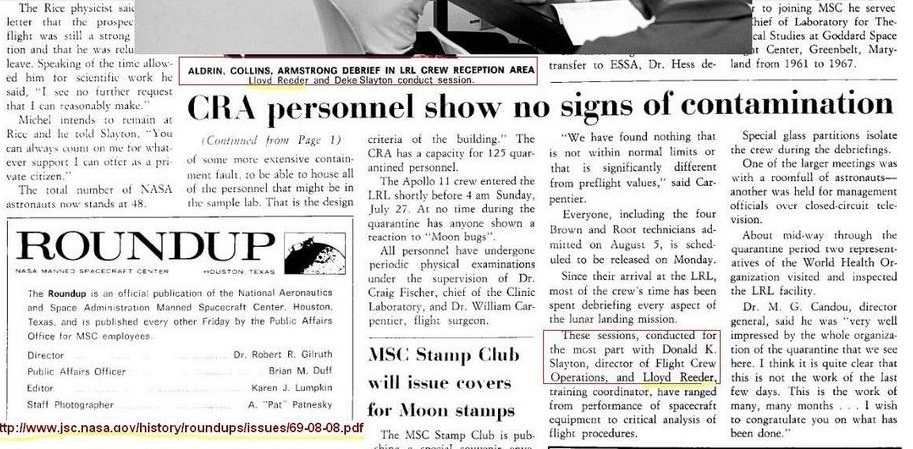
Participation in the 2TV-1 program brought Lloyd to
the attention of the astronaut office, and an assignment as Mission Training
Coordinator for Apollo 11. He coordinated all training and travel activities
for prime and back-up crews. Demand for their time was incredible. Right before
the launch he even coordinated family visits and scheduled haircuts. Some
demands on the crew came from unexpected places. For example, since both of
their sons were Eagle Scouts, Ruth Ann worked on Lloyd until he promised to ask
the crew (also Eagle Scouts) to say hello to the Boy Scouts at the 1969
Jamboree in Idaho . The crew agreed, and their greeting was written
into the flight plan and delivered during a television broadcast on their way
to the moon.
As a side bar: Deke Slayton's (Mercury astronaut)
and Dave Lowe's (Director of NASA) sons were in the same troop, at the
Jamboree, with Lloyd's two sons, Mike and Lloyd. However, his two sons (Lloyd
and Mike) were chosen to welcome Frank Borman (Gemini and Apollo 8 Astronaut)
to close the Jamboree; a task typically reserved for the President. Nixon was
busy welcoming the Apollo 11 crew back to Earth, so he appropriately sent an
astronaut in his place.
Lloyd's responsibilities with Apollo 11 wound down
during the crew de-briefing. He claims that he was only a glorified tape
recorder operator. Isn't that exactly how you would expect him to describe the
once in a lifetime thrill of sitting next to one of the original seven
astronauts, Deke Slayton, while listening to an analysis of the first landing
on the moon and the flight there and back? By the way, he was present for the
debriefing of the Apollo 13 crew after their fateful mission.
His work on Apollo 11 was greatly appreciated by the
entire crew, so Michael Collins wrote a letter of thanks, which he signed along
with Neil Armstrong and Edwin Aldrin. Lloyd's achievements were also recognized
by the Air Force, who awarded him the Legion of Merit, which was presented by
Colonel Aldrin.
As an encore, Lloyd was appointed Mission Training
Coordinator for Apollo 13. The entire family played a role in this mission.
Lloyd's sons (Lloyd and Mike) mowed Ken Mattingly's yard so he could concentrate
on training and the older of his two daughters (Ruth Ellen) exposed Ken to
measles. His youngest child (Susan) played a role by keeping him entertained in
the evenings.
Like others in your class, Lloyd participated in the
South East Asian War games. In 1970 the Air Force ordered him on a third date
with "Connies", so he returned to McClellan for a refresher course
before heading to Korat RAFB, Thailand in October. He flew
EC-121's that were dressed in camouflage and loaded with electronic gear, up
and down trails in Laos and Cambodia as well as North
and South Viet Nam . Technicians in the back monitored sensors and
called in air strikes on trucks and combatants. One unfortunate evening they
called in a strike on elephants that had escaped from a logging camp. He also
flew a "special" mission out of Saigon. The task was tracking a
VC carrier pigeon, loaded with electronic tracking devices, back to its
headquarters. Strike aircraft, soldiers, and Marines were staged and waiting
for a target. The operation was scrubbed when the pigeon died of a heart attack
while trying to climb to altitude with a load that was significantly above his
max designed/rated takeoff weight.
Ultimately Lloyd accrued nearly 7,000 hours in
various versions of the Lockheed Super Constellation, which proves that he
truly is a "Real Man"; because everyone knows that only a "Real
Man" can handle three pieces of tail at once.
Back stateside in October of 1971, Lloyd began
working with NORAD at the Cheyenne Mountain facility
in Colorado Springs , moving through a variety of staff and
leadership assignments. His final command was as Chief of the NORAD Space
and Missile Intelligence Center. Lloyd retired from the Air Force in July of
1976 to join Martin-Marietta to work on Space Defense Command and Control
Systems. He later worked on the military space shuttle launching complex
at Vandenberg AFB before the program was cancelled. Lloyd retired from Martin
in January of 1995, batting 1000, after the successful launch of the first
Titan IV Centaur/Milstar combination on 7 Feb 94 .
After retiring from a second successful career,
Lloyd settled into his woodworking shop and garden. He also became an avid bird
and wildlife watcher in the comfort of his own back yard
on Denver High-Line Canal . Currently Lloyd resides in an
Alzheimer's assisted care facility
in Littleton , Colorado . If he could remember you, he
would laugh and joke with you, and enjoy sharing stories. Thank you for
allowing me to tell you his story in his place.
Respectively prepared and submitted to Class ‘56M by
your classmate's son, Lloyd R. Reeder, with the help and support of the entire
Reeder family.
Luke H.
Boykin http://website56m.tripod.com/id16.html
Initial and Founding Director of AMRAAM
initiated in 1976 by DOD. Last Position was Director Joint System Program
Office, Advanced Medium Range Air to Air Missile. Retired as Colonel USAF in
1980. Became southeastern consultant for Alliant TechSystems when they were
bought out by Hercules Aerospace. Retired again in 1998 .
Tim T.
Daugherty
http://website56m.tripod.com/id6.html
Colonel Tim T. Daugherty (Red) was born
in Desloge , MO on 18 October 1932 . He graduated from
the University of Mississippi in 1954 and entered the Air
Force as a 2nd Lieutenant on 15 March 1955 . He completed primary pilot
training at Spence AB , GA and basic pilot training at a
combination of Williams AFB, AZ and Laughlin AFB, TX, receiving his pilot's
wings from Laughlin in April 1956 (Class of 56M).
Thomas W.
Fischer
NATO and SHELL AVIATION
http://website56m.tripod.com/id21.html
The transfer to Atlanta by Shell in
1962 took care of any more of the C119 flying, but things weren't much better
there, since the Reserve and Guard were flying C-97's and C-123's
respectively. So I opted for the Reserve and the 123's for the next three
years. Then the Reserve converted to C-124's, and if I thought the other
machines were bad, I hadn't seen anything yet. So I resigned from the unit
after a few rides, but they were persistent in their efforts to get me back, so
I returned in late 1967. Bad timing; the unit was activated January 1968
for 18 months. Shell put me on extended military leave and the unit
started a primary mission of supplying Viet Nam and flying out-sized cargo for
NATO. Between the two missions I got plenty of time grinding my way to
Southeast Asia and flying through Europe. My family, which now consisted
of my wife and two young daughters joined me for three months at RAF
Mildenhall, which was a wonderful opportunity for us to get a good look at a
lot of Europe. Shell was glad to see me after my release from active duty,
and it was back to Avation Sales. It's hard to imagine a more pleasant job.
Shell Aviation employed several luminaries in the aviation field, such as Jimmy
Doolittle, Douglas Bader, Roscoe Turner, Milt Hammon, to name a few, and it was
great fun to hear all their stories, and work with them. The airlines and fixed
base operators were also full of crusty old aviators.
But, all good things have to end, and the Shell
experience did just that when they asked me to come to Head Office, which had
recently changed from NYC to Houston, a place my family and I agreed we
did not want to live. After turning down two such offers, I felt I had
damaged my career with Shell, so I found other uses for my good high level
contacts with airlines and aviation clients. I joined Alexander &
Alexander, the leading aviation risk consultant and insurance broker. We
stayed in Atlanta for the balance of my business career, which ended
in 1996, when a competitor purchased A&A.
Jack
C. Cummings
http://website56m.tripod.com/id16.html
1972 saw Jack assigned as the Director of R
& D Procurement for the Air Force Systems Command (AFSC) at Wright
Patterson AFB, Ohio . This unit was responsible for support of
the six AFSC laboratories in Area B heavily involved in the early space and
airborne laser programs. The first pilot training simulator was contracted
for by this unit as was a good deal of the F-16 program. As a side note
this was the unit that leased the aircraft to CALSPAN that John Mitchell was
involved with.
In 1958 Jack was assigned to the audit office at
Rein Main AB in Germany to audit a variety of research and
development contracts with universities and industry
in Germany , Belgium , and France as well as the
modification of F-84s being given to Germany . Proficiency
flying was again maintained flying the C-47 throughout Europe including
the Berlin corridor, Athens , Greece , Tripoli , Egypt ,
etc.
1959 found Jack at the SABENA Plant
in Brussels , Belgium auditing the IRAN contracts
for a number of Air Force aircraft before being transferred to Mather
AFB, Sacramento , California .
From 1960 to 1966 Jack flew T-29s for navigator
training around the western United States before being assigned to
Air Command and Staff College in 1966 where he also took
advantage of the opportunity to get a Masters degree. Flying proficiency
was again in the C-47. Completing the command
and Staff College and masters program in August of 66 resulted
in an assignment to the Phyllis Ann program with duty at Tan Sun
Knut, Saigon , Vietnam . 1972 saw Jack assigned as the
Director of R & D Procurement for the Air Force Systems Command (AFSC) at
Wright Patterson AFB, Ohio. This unit was responsible for support of
the six AFSC laboratories in Area B heavily involved in the early space and
airborne laser programs. The first pilot training simulator was contracted
for by this unit as was a good deal of the F-16 program. As a side note
this was the unit that leased the aircraft to CALSPAN that John Mitchell was involved
with.
The Washington D.C. area called in
1974 and Jack was assigned to AFSC first as the Chief of R & D and Base
procurement and then as the Director of Contract Management.
This assignment was primarily a policy job for AFSC
wide coverage of procurement activities. Flying proficiency was maintained
in the C-118 until excused from flying.
This was the final USAF assignment and Jack retired
in August of 1976.
Jack went to work for the Energy Research and
Development Agency that shortly became the Department of Energy in 1976 at the
Richland Operations Office in Richland, Washington (Hanford Site) as the
Director of Contracts and Procurement.
Besides competing and selecting a billion dollar
site operating contractor the job included the selection and award of major
construction contracts for nuclear facilities and nuclear research. To
keep his hand in flying Jack acquired a new Rockwell Commander 114 for flying
around the greater northwest.
1981 found Jack out of government and starting his
own consulting business in Bellevue, Washington. This business
provides assistance to both industry and government in dealing with federal
procurement issues.
John A.
Sells
http://website56m.tripod.com/id67.html
After Vance AFB several of us were sent to Randolph
AFB for a 40 hour introduction to heavy aircraft in the B-29.
From Randolph , I was assigned to the 552nd. Airborne Early Warning
and Control Wing (AWE&C) at McClellan AFB, CA. flying the RC121 Super Connies.
Lloyd Reeder, Ken Rehg and Bill Mauser were part of the group. The counterpart
operation was at Otis AFB, MA. After separation, I joined the Reserves for
seven years and flew the C119 out of Willow Grove
NAS, Philadelphia and Clinton County AB , OH .
and the C124 out of Tinker AFB, OK. Along the way until recently, I flew some
general aviation. I reached the rank of major.
My civilian career was in the insurance business and
financial services. At one point I earned my MBA from
the University of Denver . Pat and I have four children,
eleven grand children and one great g/c.
47 grads from Class of '56 [half who went on in
internal affairs! NORAD; CIA; DOD; REDCAP; CALSPAN; AMRAAM; NRO; NGA;
NGIA]
Elmer assumed command of the 307th Air Refueling
Group at Travis AFB, California in May 1978 and held that position until
retiring from active duty in August 1980 with 26 years of service.
Elmer then accepted a position
with Lockheed Missiles & Space Company in Sunnyvale , California
in September 1980, where he performed various management and staff duties in
a black program until accepting an assignment with the Lockheed
Austin Division in early 1984 with the PLSS program. He continued
his work on the PLSS Protected Underground Facility until completion
and accepted a one year assignment in Las Vegas in August 1986 as manager of
Operations and Maintenance Support during PLSS flight testing. Upon returning
to Austin , Elmer performed various assignments until retiring from Lockheed in
January 1992 with 12 years service.
Randolph
spent a year in the Australian outback and lived in New Mexico and Hawaii
before settling in Los Angeles .
Randy was married to Anne Baxter, the
famous movie actress, who was also the granddaughter of Frank Lloyd Wright, the
architect. Their marriage lasted from 1960 to 1969 and produced two daughters,
Melissa, a nationally acclaimed interior designer and Maginel, a Roman Catholic
nun living and working in Rome , Italy .
Melissa said her father was quite a character.
"My father really was an 'Indiana Jones" type." He tried his
hand at cattle ranching in Australia , he did something else in Japan , he
would boat to Tahiti , work for Signal oil for a bit. He did pretty much what
he felt like."
On
April 27, 1956 , immediately after receiving my wings and commission, I was
married at the Laughlin AFB chapel. Subsequently, I went to “Aircraft Observer
Training for Pilots” school at James Connally AFB, Waco, Texas and
graduated with Navigator/Bombardier ratings. I was then assigned to the
98th Bomb Wing at Lincoln AFB, Lincoln , Nebraska where I flew the B-47E until
May of 1963. My next assignment was a three-year Air Force Institute of Technology
(AFIT) undergraduate Industrial Engineering program at Arizona State
University in Tempe, Arizona which was completed in January 1966. After receiving
my degree I was sent to Sheppard AFB, Wichita Falls , Texas as Chief of the
Management Engineering Detachment. This job entailed measuring the
productivity and cost efficiency of the various base activities and studying
the overall need for military manning or the cost effectiveness of using Federal
civilians versus contract civilians to provide base support services. My
“secondary job” was as a C-54 base flight pilot flying some 400 hours in 40 states
in just eight months. Received orders assigning me to Hurlburt Field, Fort Walton
Beach , Florida in January 1967 where I received training in the C-123 for
cargo hauling and the “Ranch Hand” Agent Orange Program. After training
I was assigned to Nakom Phanom RTAFB, Thailand in an unique CIA program
called ”Candlesticks” –flying night missions as a forward air controller (FAC)
logging 200 combat hours in 50 missions over Laos and North Vietnam .
Five months into my tour I was sent TDY to Bangkok ’s Don Muang RTAFB to
instruct Thai pilots in C-123 combat tactics. During my year, I logged
900 hours in the C-123. Back from southeast Asia in March of 1968 I returned to
SAC with B-52 training at Castle AFB , Atwater , California and subsequent
assignment to Barksdale AFB, Shreveport , Louisiana. While at Barksdale,
in July 1969 I returned to SEA on one”arc-light” tour (Anderson AFB, Kadena
AFB, U-Tapao AFB) logging 300 combat hours in 40 missions. Returning to
Barksdale, I was assigned to Command Post duty which led to a PCS as a
controller at Castle AFB, California in January 1971 and a secondary job as
base flight pilot flying the T-29B. In May of 1972 I was again selected for
AFIT at Arizona State University receiving my Masters Degree in
Engineering Management in August 1973. Next assignment was to
the Pentagon as a Manpower Temp Agency Management staff officer
regulating and directing to Command and base level manpower offices the need
for military manning and the cost effectiveness of using Federal civilians
or contract civilians in base support functions. I elected to retire
from my Air Force career in August 1977. Retired in Merced , California and
remain here today. After a year of loafing, I joined other Air Force retirees
in the Curtis Mathes retail television business until February 1996. Since
retirement from the Air Force in 1977 much of my time has been devoted to
travel and golf. Personal data includes two children: Daughter, Linda Anderson, Central
Intelligence Agency Headquarters, CIA.
Married
4 June 1959 to Anne Selph MacKay four sons, seven grandchildren. Completed
single-engine training at Del Rio , Texas. Assigned to Sewart AFB, TN Flew
C119s and C123s 1000 hours. Graduated from Law School June 1961. Florida House
of Representatives 1968 to 1974. Florida Senate 1974 to 1980. US Congress 1982
to 1988. Lt. Governor of Florida 1990 to 1998. Governor (serving remainder of
term) 12/1998 to 01/1999. Presidential Special Envoy to Latin America 02/1999
to 01/2001. Currently adjunct professor at Univ. of Florida College of Law. Co-founder
of Center for Rule of Law in the Americas. Juvenile dependency mediator.
First
I was flying B-25s on Shoran Training then T-29s for Navigator/Bombardier
Training. While living in Sacramento I met and married Barbara Brower who was
working for Aerojet General. She is still my wife after 46 years, four children
and siix grandchildren. For most of that time we have lived in Atlanta with
some long commutes in between. We still call Atlanta home.
After discharge in 1958 we moved to Phoenix
where I worked in sales for a year before joining Frontier Airlines as a
copilot in Denver and Omaha . Frontier downsized me out of a job (this was
1959; sound familiar?) so we moved to Atlanta with the late Southern Airways,
later Republic Airlines. I flew DC-3s, M-404s, and DC-9s as copilot and then
captain. I also flew as a Check Airman and for a time I was Vice President of
Flight Ops. After retiring at age 51, I went into the business of starting
low cost and commuter airlines (Jet Express, dba Midway, Bader Express) and
ended up as Vice President Flight Ops for Atlantic Southeast Airlines in Atlanta
. I finally retired in 1998.
I stayed in the Reserve and finished 28 years
with two recalls. In the Cuban Missile Crisis in 1963 we were to air
land the 82nd Airborne flying C-123s. That was a short recall when the Russians
backed down. When the North Koreans captured the U.S. intelligence ship
Pueblo in 1968 we were recalled flying Ole Shaky, C-124s. We ended up
flying all over the world, starting with Viet Nam and Tet. But in the
last year we were part of a provisional Wing out of Mildenhall RAFB , UK . We
flew Europe and the Middle East and some downrange to the Caribbean and South
America . Except for low and slow it was fun flying.
As I said above, I retired from the airline
business in 1998 with a brief return to work in 1999.
On
January 1, 1956 , I was enroute to Laughlin AFB in Del Rio , TX . I was
married three days prior on Dec. 30, 1955 to a beautiful Swedish blonde,
Alice Carlson, so we were on our honeymoon. We rode in style as we
had bought a new red and white Ford convertible. After several months of
basic training I made a decision not to sign indefinite but to serve out my
specified time contract of three years on active duty. Between graduation
from college and going in the Air Force, I worked for Procon, Inc. which
hired me out of college and I promised to return after three years. If I
had it to do over again, I would have stayed on active duty. So I was
given a choice of bases, either Larson AFB in Moses Lake, WA, where they had
C-124s or Pope AFB in NC where they had C-119s. Since I didn’t like the
C-word in front of airplane types, I chose Larson for the simple reason I had
never lived out west. There I flew out of base flight in C-47s and got
four to eight hrs. per month flying time. I was assigned as group
maintenance officer as I had a BSME degree from GA. Tech. The work
and flying was rather uneventful and I chose to serve out my time on active
duty. In 1958, Alice and I left and returned to Chicago where I started
work with Procon in Des Plaines. I was to be a construction
superintendent trainee in building oil refineries and petrochemical
plants. However, at the time, construction jobs were few, so I worked in
the process design department doing more chemical engineering than
mechanical. I immediately joined the AF reserve at O’Hare Airport flying
the C-119. (the Air Guard was full). After several years the future of
the company looked dim and the construction in the industry had slowed down
immensely. So in 1961 I was hired by the AF as a civilian engineer to
work on the Titan and Atlas missile systems at Norton AFB, CA.
I joined the C-119 reserve unit at March AFB. After a few years I worked
for TRW, Inc. in San Bernardino , CA in support of the missiles at
Vandenberg AFB. In 1965 they had few new contracts with the AF and
many of the engineers were leaving for greener pastures. Some of my
fellow pilots in the reserve were being hired by the airlines. So one day
while passing through the LA airport, I saw a United Airlines sign. I
picked up an employment application and after an interview and check ride in a
simulator I was hired. I started in the spring of 1966 and flew for 30
years until I retired in the spring of 1996. I flew out of O’Hare my
entire career.
http://www.aviastar.org/air/usa/boeing_b-50.php?p=5#cmt Yokota
airbase personnel speak out today!
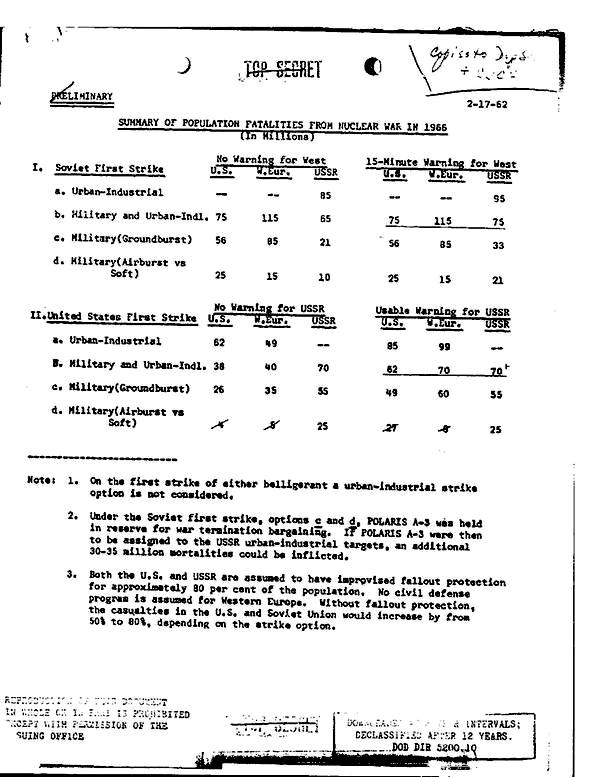

WASHINGTON — (Sept. 2018) Recently declassified documents https://nsarchive.gwu.edu/briefing-book/nuclear-vault/2018-08-15/us-nuclear-war-plan-option-sought-destruction-china-soviet-union-viable-societies#_edn13
shed light on a U.S. nuclear war plan developed in 1964 by the Pentagon’s Joint
Staff to bomb Russia – then the Soviet Union – and China with nuclear weapons
so extensively that it would destroy them “as viable societies.” The war plan
itself, known as Single Integrated Operational Plan 64 (SIOP-64), has not been
declassified, as no SIOP has ever been released to the public by the United
States government.
https://www.mintpressnews.com/declassified-docs-reveal-pentagon-plan-to-destroy-ussr-china-as-viable-societies-with-nuclear-weapons/248644/
However, newly declassified documents that record the Pentagon Joint Staff’s
review of SIOP-64 were recently made available through George Washington University’s
National Security Archive project. The documents reveal numerous details about
the still-classified plan that shine light on the Pentagon’s willingness to
wage nothing short of total war against its adversaries at the time. In
particular, the documents show that the plan sought to accomplish the
destruction of Russian and Chinese society by targeting and eliminating their
industrial potential while also wiping out the majority of their urban
populations. Still more troubling, urban civilians were proposed to be the main
target and measure of the U.S. nuclear war plan as the Joint Staff sought
to use “population loss as the primary yardstick for effectiveness in
destroying the enemy society, with only collateral attention to industrial
damage.” https://nsarchive2.gwu.edu/nukevault/ebb281/2A.pdf
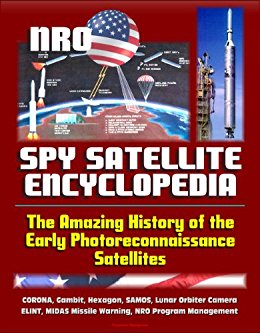
Spy Satellite Encyclopedia: The Amazing History of the
Early Photoreconnaissance Satellites, CORONA, Gambit, Hexagon, SAMOS, Lunar
Orbiter Camera, ELINT, MIDAS Missile Warning, NRO Program Management –
published by NRO National Reconnaissance Office
The previously classified
documents in this collection, converted for accurate flowing-text e-book format
reproduction, were released by the NRO in September 2011 as part of its 50th
anniversary.
·
File Size: 46985 KB
·
Simultaneous Device Usage: Unlimited
·
Publisher: Progressive Management (October 20, 2012)
·
Publication Date: October 20, 2012
·
Sold by: Amazon Digital Services LLC
·
Language: English
·
ASIN: B009UF1816